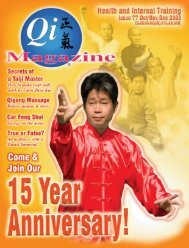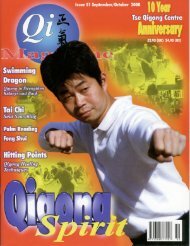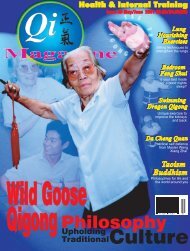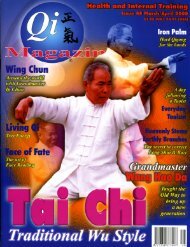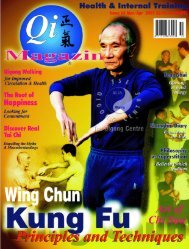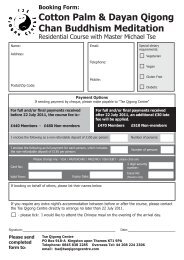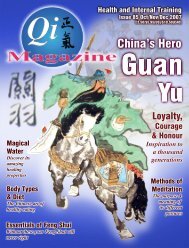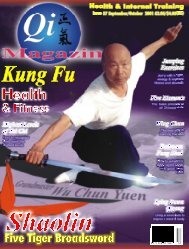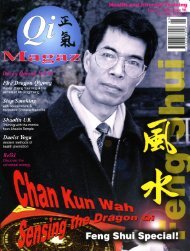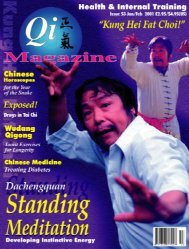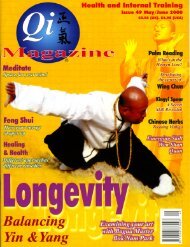Issue 78 - Tse Qigong Centre
Issue 78 - Tse Qigong Centre
Issue 78 - Tse Qigong Centre
- TAGS
- issue
- qigong
- qimagazine.com
You also want an ePaper? Increase the reach of your titles
YUMPU automatically turns print PDFs into web optimized ePapers that Google loves.
Shoulder To The Wheel<br />
I<br />
have always been impressed and<br />
fascinated by my Sifu’s Taiji. When I<br />
watch him perform a slow form I can<br />
see quite clearly how his body opens and<br />
closes with each posture in a very<br />
dynamic way, how the upper body<br />
reflects the energy of the legs. For<br />
example, in the move “Jin Gang Comes<br />
Out From The Temple”, I can see the left<br />
side of the chest opening up from the<br />
push of the right foot. This is known as<br />
Yin/Yang ribs – no, not a delicacy from<br />
your local restaurant, but an example of<br />
the waist governing upper body energy<br />
via the push of the legs.<br />
Some moves, such as “Lazily Tying<br />
The Cloth”, contain not only an opening<br />
of the front of the shoulder but also a<br />
prior opening of the rear of the shoulder.<br />
“White Crane Spreads Its Wings” contains<br />
both, plus a forward spiral of the point<br />
of the shoulder. It’s like putting your<br />
shoulder to an enormous rotating wheel.<br />
So, Taiji is quite complex, but endlessly<br />
absorbing too.<br />
Our forms can be performed in<br />
so many different ways. If we pay<br />
particular attention to the opening and<br />
closing of the upper body, usually in a<br />
fairly high stance, taking care also to be<br />
nice and straight and upright in postures<br />
There is something very addictive about Taijiquan. You can<br />
get lost in practice as there is so much to see and so much to do.<br />
However, we must always remember to train “Smart” and then we<br />
can make good headway.<br />
such as “Jin Gang Pounds The Mortar”<br />
and some of the kicks, our routines leave<br />
us quite light and energised. However,<br />
leg strength is important too and if we<br />
stay low, particularly through<br />
the longer forms, making it<br />
harder also to work the<br />
waist, then we really<br />
feel it at the end<br />
(or about a third<br />
“Some moves<br />
contain not only an<br />
opening of the front, but<br />
also a prior opening<br />
of the rear of<br />
the shoulder.”<br />
page 10 Qi Magazine Jan/Feb/Mar 2006<br />
of the way in if I’m honest!).<br />
We can make our movements big<br />
and round or accentuate the various Fa<br />
Jing (explosive energy) opportunities such<br />
as “Single Whip” or the shake just before<br />
“High Pat On Horse” in the Xin Jia. When<br />
we sink or sit down on one leg we should<br />
be careful to distinguish between these<br />
and other postures which may require an<br />
active (ie- pushed) transfer of weight from<br />
one leg to another. It’s a bad habit to<br />
simply rest the weight on one leg if the<br />
posture requires that we should have<br />
pushed our weight over from the other<br />
side. A good example of this is the<br />
opening moves before “Wade Diagonally<br />
Forward”. If we don’t “push” the weight<br />
over, we can’t open the upper body<br />
properly either.<br />
Smaller details are important too.<br />
Too many Taiji players keep the fingers<br />
open on the pushes. We should close<br />
our fingers and the Hegu acupuncture<br />
points (between thumb and<br />
forefinger), thus bringing strong<br />
energy to the palms and the base<br />
of the fingers. It also makes it<br />
harder for an opponent to<br />
grab or twist our joints.<br />
When we’re opening up<br />
the arm in a circular<br />
fashion, for example in<br />
“Single Whip” or “Lazily<br />
Tying The Cloth”, we<br />
shouldn’t tilt the little<br />
finger too far upwards,<br />
this raises the shoulder too<br />
much – keep the hand<br />
slightly flatter.<br />
At the risk of<br />
repeating what I’ve said in<br />
previous articles, the hips<br />
are fundamental. (See a<br />
thousand previous<br />
rhetorics, all entitled “It’s<br />
always the hips!”).The<br />
inguinal creases in<br />
front of the groin<br />
should always be<br />
hollow as if<br />
we’re sitting<br />
down. If the<br />
hips aren’t right,<br />
t h e n n o t h i n g<br />
else will be – it’s that<br />
i m p o r t a n t . Bad hips<br />
can cause the knees to<br />
buckle in and give pain and will<br />
also affect the shoulders.<br />
So there’s always something to<br />
improve in our Taiji, the forms should<br />
always be new and exciting. All we need<br />
is another fifty lifetimes to put our<br />
shoulder to the wheel<br />
by Julian Wilde.<br />
jules@qimagazine.com



